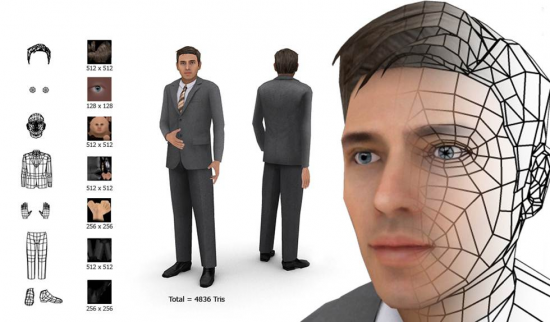Press release:Â VastPark Launches OpenAvatar for Virtual Worlds and Games
Washington, DC & Melbourne, Australia — VastPark, an industry leader in virtual worlds, launches OpenAvatar to create an open source standard generator for avatar development for the virtual world and gaming industry.
Frustrated by the lack of high quality 3D avatar generators, the VastPark team has launched OpenAvatar, a flexible open 3D avatar specification and open source generator that uses the industry-standard Collada format. The free OpenAvatar SDK makes it possible for virtual world platforms to enable users to customize their avatars with swappable body parts and it supports a range of deployment options such as in the cloud and behind the firewall.
The Genesis of OpenAvatar
When the VastPark team wanted to offer their users a way of customizing 3D avatars inworld, they found a big problem. There weren’t any avatar generation systems available that provided the scalable, high quality results they were looking for. In particular, there was no open source solution offering quality results or using an industry standards-based toolset.

Bruce Joy, founder and Chairman of VastPark said “We know that there are great vendors like DI-guy offering good quality avatars and amazing technologies like Facegen and Shapeshot, but no one was offering an end-to-end avatar generator that incorporated these sorts of technologies in a fully reusable way. So when we decided to go ahead with this, we knew it had to be open source, easy to use for commercial projects and offer really high quality results. Why? Because want other developers and platforms to adopt it!”
Lori Kavle, President of VastPark US, explained the strategy, “Our business is focused on our community of practice, web services and virtual worlds platform that integrates whatever is needed to give users an effective and rich immersive experience. We believe strongly that by improving interoperability between virtual world platforms, we can all help the industry mature and grow. If the industry grows, then so do we.â€

What Makes OpenAvatar Different?
As the manager of the Melbourne R&D team for VastPark, Tim Glew has been responsible for driving this project forward. “Most developers are going to be surprised how simple and flexible the OpenAvatar system is,” believes Glew. “The benefit is that the developers can define the avatars features and still let their users customize them with their own artwork. These avatar ‘archetypes’ as we call them, could be anything from a realistic avatar to a 3 headed dragon! The system doesn’t tie the developer into a specification that we’ve created. It lets them define their own avatar specifications.”
Jeremy Massey is the senior artist who originally conceived OpenAvatar. “I was frustrated by what I found available. 3rd party commercial solutions didn’t allow for inworld customization of avatars which made the whole user experience clunky and I knew it didn’t have to be like that. I also wasn’t satisfied with the quality of the avatars I was receiving from these 3rd party systems.”
Bruce Joy agrees, “It wasn’t just us who were frustrated by the quality of the 3rd party avatar generators but our customers were dissatisfied as well. So it’s really gratifying to see the quality and range we’re able to achieve with OpenAvatar.”
Massey made sure that 3D modelers could use their existing design tools to create the components for avatars by having OpenAvatar automatically rig the avatar so it handles animations. Massey explains; “Artists simply bind their model to their entire rig using standard practices in their application of choice and then export to an OpenCollada file. The OpenAvatar Generator handles the rest. This means end users can mix and match body parts on their animated avatar.”
“What excites me is that if a developer devises a new avatar specification, the system will generate that avatar in the Collada format and then it’s easy for that file to be converted into a range of runtime formats to suit various platforms. We’ve already done tests that created the same avatar in Unity3D and in VastPark.” said Joy. “Conceivably, there’s no reason it can’t work in other mesh-based platforms as well. Avatar interoperability between disparate systems is now really within reach, but it will take good will on the part of various vendors to try using the platform”
Announcing the OpenAvatar SDK and Request for Community Feedback
We’re announcing today that the OpenAvatar SDK is now available to partners for immediate trial. A public version will follow soon with the avatar generator released under an MIT open source license which makes it perfect for both commercial and non-commercial use. High quality example artwork is also included under a Creative Commons license so that developers can test the system and work out how to get an avatar generated with the OpenAvatar Generator into their own platform. The OpenAvatar specification is provided royalty-free under an open specification promise.
Lori Kavle described today’s release as focused on getting feedback, “We’re providing the OpenAvatar SDK to interested partners so we can hear feedback. If people are excited by what they can achieve with the SDK then we know this is a big step forward for virtual world interoperability. I know by the amount of buzz we had at the recent Federal Consortium for Virtual World (FCVW) conference that we are on the right track.”
For more information about OpenAvatar, see www.vastpark.org/projects/vp/wiki/OpenAvatar. To request access to the SDK prior to the public release, contact the VastPark team via email ( sales@vastpark.com).
- Major companies to discuss metaverse plans at December conference - August 22, 2023
- OpenSim Community Conference starts today - December 11, 2021
- Ninth Annual OpenSimulator Community Conference set for December - October 18, 2021
